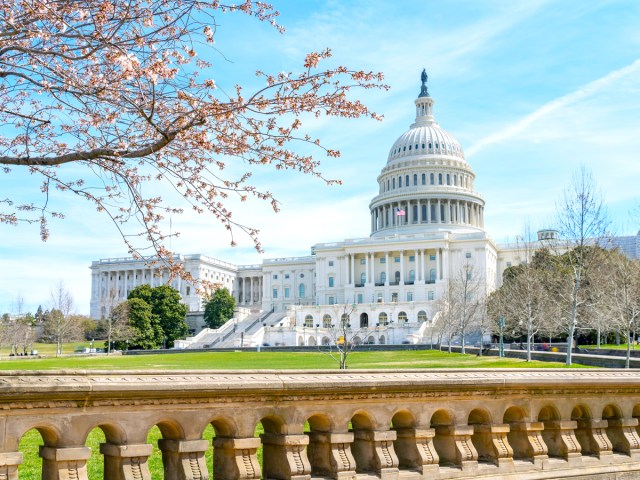It’s been over six decades since Alaska and Hawaii became the most recent states to join the Union, in January and August of 1959, respectively. In the years since, the total number of stars on the American flag has remained exactly the same, though not for a lack of trying. Advocacy groups have led various pro-statehood efforts in several locations that could very well become the 51st state someday. If that were to happen, it would be an exciting prospect for travelers, too. That got us curious: What exactly does it take to become a state? Here’s a look at the recent history of U.S. statehood and what it would take to add any new states in the future.
Statehood During the 20th Century

Five states were admitted to the Union during the 20th century: Oklahoma in 1907, New Mexico and Arizona in 1912, and Alaska and Hawaii in 1959. The first of those, Oklahoma, was formed as a U.S. territory in 1890. In 1906, Congress authorized the Oklahoma Enabling Act, which empowered the people of Oklahoma to draft their own state constitution. On September 17, 1907, locals voted in favor of statehood, and on November 16, 1907, President Theodore Roosvelt issued Presidential Proclamation 780 to formally admit Oklahoma as the 46th state.
Meanwhile, New Mexico had been an organized incorporated territory since 1850, while the Territory of Arizona existed as far back as 1863. In later years, the quest for statehood proved to be an arduous process due to border disputes and other political disagreements. Finally, in 1910, both New Mexico and Arizona drafted their state constitutions, and Congress approved a joint statehood resolution on August 21, 1911. President William Howard Taft signed the legislation soon after, admitting New Mexico as the 47th state on January 6, 1912, and Arizona as the 48th state on February 14.
Alaskans voted for statehood in 1946, and the state adopted a constitution in 1956. On July 7, 1958, President Dwight D. Eisenhower signed the Alaska Statehood Act, recognizing the state’s strategic importance during the Cold War. It was admitted to the Union on January 3, 1959, as the 49th state. Alaska’s successful statehood bid renewed a long-standing push for Hawaiian statehood, for which a bill was first introduced back in 1919. On March 18, 1959, U.S. Congress voted to approve the Hawaii State Admission Act. Hawaiians voted for statehood in June 1959, and the Hawaiian territory finally became the 50th state on August 21 of that year.
How the Admission Process Works

The decision to admit a new state lies solely with the United States Congress. While members may take into account local statehood referendums and other lobbying efforts, it all comes down to whether the bill gets congressional approval in both houses. These rules are written in Article IV, Section 3 of the Constitution, which says, “New States may be admitted by the Congress into this Union; but no new State shall be formed or erected within the Jurisdiction of any other State; nor any State be formed by the Junction of two or more States, or Parts of States, without the Consent of the Legislatures of the States concerned as well as of the Congress.”
Essentially, statehood isn’t tied to the will of the people fighting for statehood — it’s whatever Congress ends up deciding. Locations including Puerto Rico and Washington, D.C., have held multiple referendums over the years in which locals voted in favor of statehood, but none resulted in statehood because Congress either ignored the referendums or voted them down. That said, the statehood process still begins on a local level. A convention is held to draft a state constitution, which is sent to voters for approval and ultimately submitted to Congress for consideration.
Statehood can’t be formally approved until legislation is introduced in Congress. For instance, the Washington, D.C. Admission Act was introduced in 2019, 2021, and 2023. However, the bill was not held for a vote in either 2019 or 2023, and only the House voted on it in 2021. Meanwhile, in 2022, the House approved a bill that would have committed to the results of a Puerto Rican statehood referendum, but that bill was never taken up by the Senate. Should both houses ever vote and approve one of these bills, the legislation would then be sent to the president for their official signature before becoming official.
What Are the Odds of a 51st State?

Currently, ongoing political posturing makes the likelihood of a 51st state in the near future quite slim. Members of the Republican Party have opposed D.C. statehood, fearing that it would give Democrats two new senators and several new House representatives, and there’s a similar ongoing debate regarding Puerto Rican statehood. Until the political climate in Congress changes, it’s hard to imagine any would-be state garnering the required support it would take to join the Union.
However, the push for statehood remains strong among residents of the areas that could become the 51st state. For example, 86% of D.C. residents voted in favor of statehood in 2016, and 53% of voters in Puerto Rico also voted for statehood back in 2020. This continued support makes it likely that bills will continue to be introduced in Congress, whether they’re eventually voted upon or not. Until then, while the prospect of a new state may be enticing, travelers have plenty to explore in the existing 50 states.
More from our network
Daily Passport is part of Optimism, which publishes content that uplifts, informs, and inspires.























